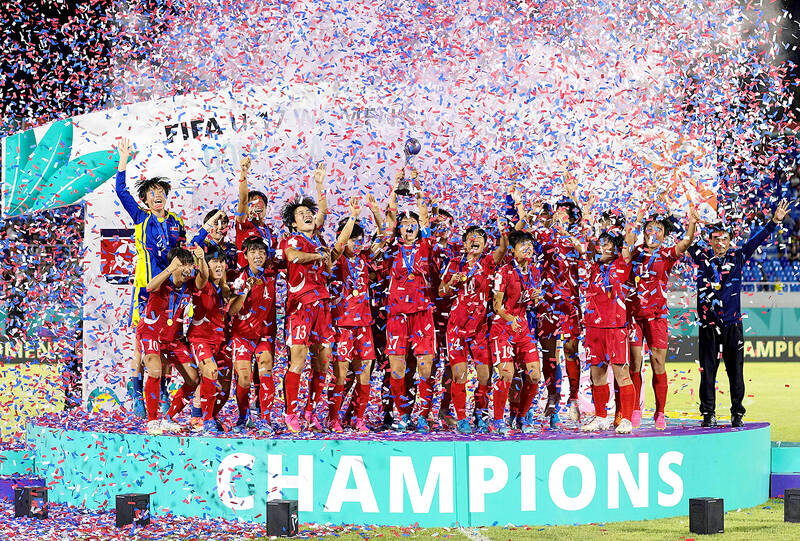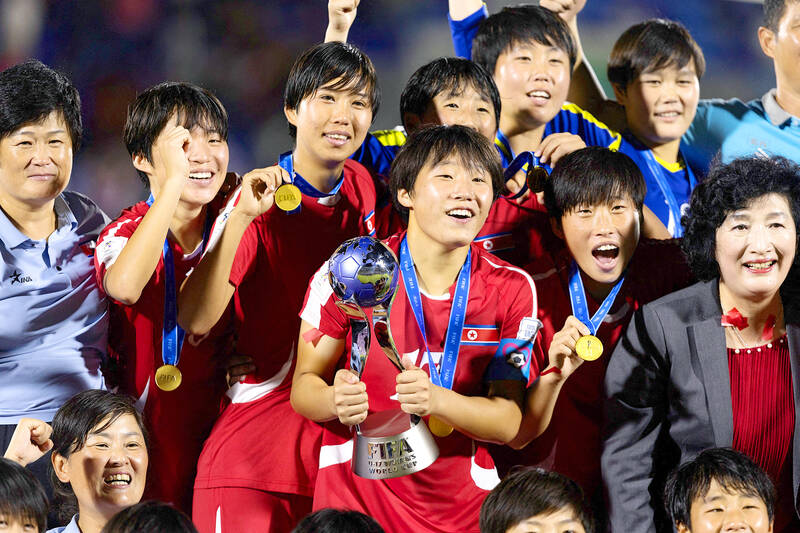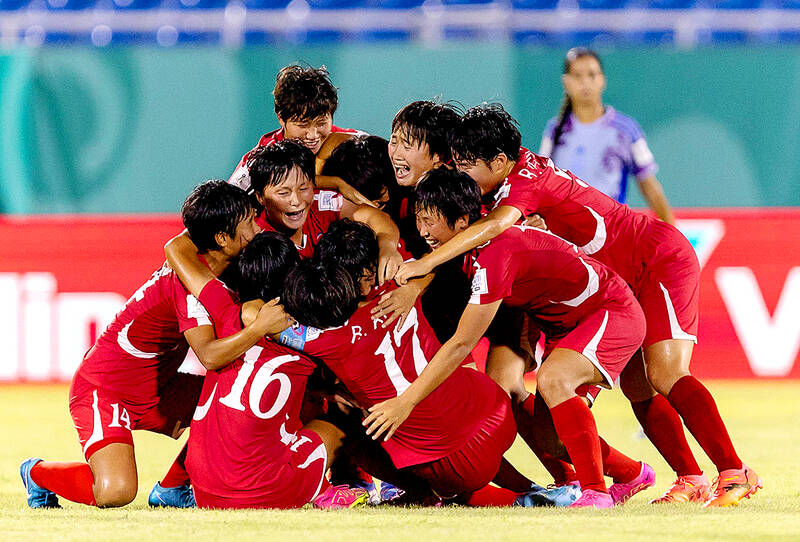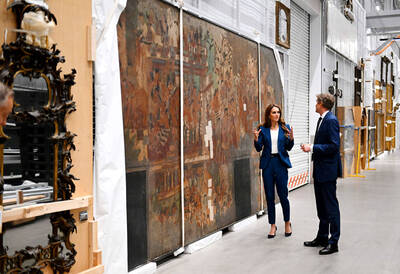Talent, discipline and a desire to please leader Kim Jong-un have helped propel North Korea’s youth footballers to two Women’s World Cup crowns in a matter of weeks, experts say.
Nuclear-armed but impoverished, North Korea is more often in the news for sanctions-busting ballistic missile launches.
But after winning the under-17 Women’s World Cup on Sunday, state media proclaimed that the country’s teenage players were “the attention of football experts, fans and spectators across the world.”

Photo: AFP
The U17 triumph came after North Korea — largely closed off to the outside world — also lifted the Women’s World Cup at under-20 level in September.
“I want to first share this joyous news with our beloved father and leader Kim Jong-un,” under-17 goalkeeper Park Ju-gyong said. “I am so happy and overwhelmed that I can’t help but cry.”
Giving thanks to the Kim family is a tradition for North Korean athletes after notable victories.

Photo: AFP
Lee Sang-yoon, a former player for the South Korean men’s team, said that North Korea’s women footballers are “very skillful and known for their stamina.”
He said that the “political system” also comes into it — in that “they strictly adhere to predetermined play patterns in terms of formation and tactics.”
Irune Dorado, part of the Spain under-17 team beaten on penalties in the final, called the North Koreans “a very intense team.”

Photo: AFP
“They don’t let you breathe,” she told the FIFA Web site.
WHY WOMEN?
Across the board, North Korean women appear to outperform men at sport.
At the Hangzhou Asian Games last year, out of a total of 11 gold medals, 10 were won by women athletes.
When the government picks North Korea’s top 10 athletes of the year, it is often mostly women.
“While North Korean society is extremely patriarchal in many ways, the state is more than willing to elevate female athletes to the same — and in some cases higher — level as their male counterparts,” said Shreyas Reddy, a North Korean analyst at the Web site NK News.
The logic behind it is simple.
“It represents a greater chance of success,” he said.
North Korea’s men have been to the World Cup twice, famously reaching the quarter-finals in England in 1966. They are currently ranked 111 in the world.
Their female counterparts have been to the Women’s World Cup four times, getting to the quarter-finals in 2007. They are ranked ninth.
It has changed in recent years, with European nations investing in women’s football, but for decades North Korea seized their chance in the female game when other countries weren’t so interested, experts say.
The two recent World Cup victories were not one-offs.
North Korea have won each tournament a record three times, although that is yet to translate into success when it comes to the biggest prize of all, the Women’s World Cup.
Former Premier League striker Shaun Goater was a member of FIFA’s technical study group at the under-17 tournament and watched every North Korea match.
“They are a really organized, fit, athletic team with a high level of technical ability and game understanding,” he said.
Winger Jon Il Chong walked off with the Golden Ball award for best player at the competition.
Another possible star of the future is countrywoman Choe Il Son. She was named the best player and was top-scorer at the under-20 World Cup.
‘FOOTBALL FAN KIM’
North Korean defector Cho Mi-young says that the state plucks the best budding footballers from primary schools across the country and brings them to the capital Pyongyang.
“As it’s one of the few opportunities for North Korea to gain positive attention in the international community, the country is dedicating significant resources to developing talented athletes,” Cho told Radio Free Asia.
The players undergo years of intense training, but Cho said “the strong mentality and tenacity of North Korean women might have been the biggest factor in their victory.”
“Their genuine belief in the need to please their leader” is another major motivation, said Cho.
Kim is said to have a passion for football and a “Pyongyang International Football School” opened two years into his rule.
Heo Jeong-pil, a professor of North Korean studies at Dongguk University in Seoul, said Kim had lent his “interest and support” to women’s football.
Heo put the teams’ successes down to “their powerful physical conditioning combined with solid resolve.
“This drive is particularly motivated by an intense desire to enhance national prestige, a motivation that is notably stronger compared to other countries.”

One of the most important gripes that Taiwanese have about the Democratic Progressive Party (DPP) is that it has failed to deliver concretely on higher wages, housing prices and other bread-and-butter issues. The parallel complaint is that the DPP cares only about glamor issues, such as removing markers of Chinese Nationalist Party (KMT) colonialism by renaming them, or what the KMT codes as “de-Sinification.” Once again, as a critical election looms, the DPP is presenting evidence for that charge. The KMT was quick to jump on the recent proposal of the Ministry of the Interior (MOI) to rename roads that symbolize

On the evening of June 1, Control Yuan Secretary-General Lee Chun-yi (李俊俋) apologized and resigned in disgrace. His crime was instructing his driver to use a Control Yuan vehicle to transport his dog to a pet grooming salon. The Control Yuan is the government branch that investigates, audits and impeaches government officials for, among other things, misuse of government funds, so his misuse of a government vehicle was highly inappropriate. If this story were told to anyone living in the golden era of swaggering gangsters, flashy nouveau riche businessmen, and corrupt “black gold” politics of the 1980s and 1990s, they would have laughed.

It was just before 6am on a sunny November morning and I could hardly contain my excitement as I arrived at the wharf where I would catch the boat to one of Penghu’s most difficult-to-access islands, a trip that had been on my list for nearly a decade. Little did I know, my dream would soon be crushed. Unsure about which boat was heading to Huayu (花嶼), I found someone who appeared to be a local and asked if this was the right place to wait. “Oh, the boat to Huayu’s been canceled today,” she told me. I couldn’t believe my ears. Surely,

Imagine being able to visit a museum and examine up close thousand-year-old pottery, revel alone in jewelry from centuries past, or peer inside a Versace bag. Now London’s V&A has launched a revolutionary new exhibition space, where visitors can choose from some 250,000 objects, order something they want to spend time looking at and have it delivered to a room for a private viewing. Most museums have thousands of precious and historic items hidden away in their stores, which the public never gets to see or enjoy. But the V&A Storehouse, which opened on May 31 in a converted warehouse, has come up